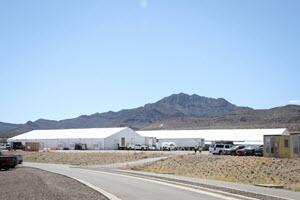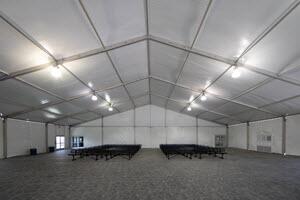The Trump administration has put up two massive tents to hold migrants in cities along the U.S.-Mexico border where nearly three-quarters of migrant families are arriving, U.S. Customs and Border Protection said Monday.
Department of Homeland Security officials chose to stand up the “soft-sided” facilities in Donna, Texas, and El Paso, Texas, this month to provide a “safe environment with a level of comfort” for people who have traveled hundreds of miles “at the very least, in less than humane conditions,” according to Eric Eldridge, Customs and Border Protection’s Office of Facilities and Asset Management’s Facilities, Management and Engineering director.
Customs and Border Protection officials overseeing the projects were given 30 days to plan for and install the structures, and were able to make it happen in 22 days. The agency awarded 50 contracts in that time and quietly opened the facilities May 4.
“Once given the OK to move forward, we all had the approach and attitude that we have to get this up as fast as possible. So, it’s been seven days a week,” Eldridge said in a statement.
The agency was criticized after photos published by CNN last week showed people sleeping and sitting outside a Border Patrol station in nearby McAllen, Texas, because the facilities were too crowded to accommodate everyone indoors.
The new vinyl structures are 400 feet long and 100 feet wide, and they can hold 500 people at a time. The tents come with modern amenities and are climate-controlled to withstand the 100-degree temperatures South Texas sees during the summer months.

The facilities have separate areas inside for eating, sleeping, recreation, and bathrooms. Those areas include showers, chemical toilets instead of outhouses, sinks, laundry machines, sleeping mats, kitchen equipment, and storage for personal items. Migrants in custody receive “mats, blankest, hot meals and snacks, drinking water, diapers, wipes, clothing sets, and hygiene kits,” the agency said.
Border Patrol agents have administrative areas to conduct interviews with those in custody and medical screenings. The agency installed security cameras and has guards working inside and outside each facility.
Seventy-one percent of migrant families are arriving in two of the Border Patrol’s nine regions along the southern border: the Rio Grande Valley, where Donna is located, and the El Paso region, which includes all of the New Mexico-Mexico border. Nearly 175,000 of the 248,000 family units taken into custody since October were encountered in those two regions.
In the first six months of fiscal 2019, El Paso agents took 74,072 people into custody after they illegally crossed the international border and claimed to be traveling with a family member. In the Rio Grande Valley, the southernmost part of the United States, 101,857 family members were apprehended.
“Rio Grande Valley and El Paso sectors are encountering the highest number of family units and are more geographically challenged sectors,” Matthew Roggow, U.S. Border Patrol associate chief, said in a statement.
[Also read: DNA tests reveal 30% of suspected fraudulent migrant families were unrelated]

Sixty percent of people apprehended at the southern border in April were Central American families, not single adults from Mexico, which historically made up the majority of illegal crossers. Families take three to four times longer to process.
“The reality is our facilities were built for single adults. They weren’t built for the current demographics that we’re detaining,” Roggow said.
Eldridge said the agency is also planning a permanent hub in El Paso that can hold 2,000 people at a time. It would be the biggest centralized processing center in the country, topping the current largest in McAllen, which can hold up to 1,500 at a time. The agency was given $192 million for the project in the supplemental funding bill Congress passed in February.
The agency is also looking at an “intermediate solution of an 800-capacity modular structure in El Paso” in addition to the permanent one.
